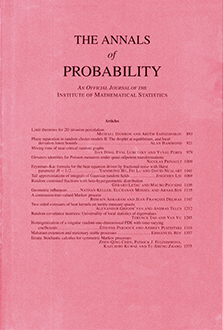Abstract
In 1963 Glauber analyzed a one dimensional model for magnetism. It was the first study of the Markovian time evolution of a system with infinitely many interacting components. In Section 1 it will be discussed in the light of recent progress in this field. The remaining Sections (2, 3, and 4) form an introduction to recent joint work with Thomas M. Liggett. They concern new types of systems where each component takes on a real value which fluctuates in a way depending linearly on the values of neighboring components. The ergodic theory for such systems with finitely many components is the subject of Section 2. The results suggest conjectures for the case of infinitely many components, stated in Section 3 and proved in the joint paper with T. Liggett (ibid.). Section 4 introduces another class of time evolutions whose ergodic behavior may be analyzed by similar methods.
Citation
Frank Spitzer. "Infinite Systems with Locally Interacting Components." Ann. Probab. 9 (3) 349 - 364, June, 1981. https://doi.org/10.1214/aop/1176994410
Information





